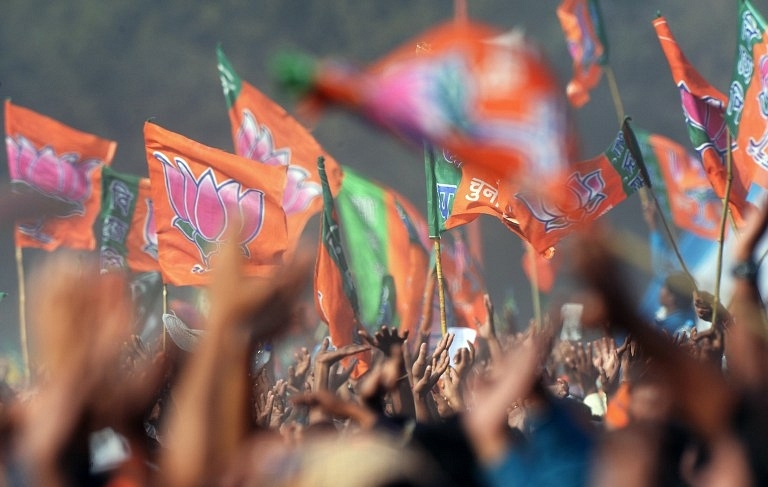Politics
Bihar Exit Poll Summary: BJP Moves Further Ahead

The exit polls appeared to have muddled the picture but the sense one gets after looking at the data in depth is that the NDA is ahead.
Here are the key takeaways on the basis of my previous article on expectations from Bihar exit polls.
Vote Share gains/losses: Both alliances appear to have gained marginally with NDA gaining nearly a percent of vote (Within margin of error). These small gains do not appear to be logical given that there were many undecideds before the first phase (5-6%). The trends seem to suggest that most of them are voting for others.
All the 4 mainstream polls considered in this analysis (C-Voter,Chanakya, Cicero & Nielsen) show one common trend, small gains in vote share for MGB. The difference between Chanakya and the other pollsters is in the forecast for the NDA.
There is a clear 5.2% gap between the pollsters. However, there appears to be a solid logic behind this difference. Looking at the caste voting comparisons between C-Voter and Chanakya below, while there are some variances, applying caste weights to this data produces almost identical vote share for NDA (around 41%). So if Today’s Chanakya is producing a 46% share for NDA, it can only be possible if they are applying different caste weights from rest of the pollsters.
Is Today’s Chanakya right? They were very close with vote share forecasts in Bihar in the 2014 Lok Sabha election (38% forecast vs 39.5% actual). This means that their caste weight model has worked before . While they got the Jharkhand (a neighbour) assembly seat forecast wrong by a wide margin, the got the vote shares absolutely right. To summarize, Chanakya’s forecast differences are not because of some ambitious outlier calls but because they appeared to be applying different caste weights from rest of the industry.
Here is the track record of all the 4 pollsters in Bihar Lok Sabha 2014 (seat forecasts only)
To give where credit is due, C-Voter was also close with a forecast of 28 seats.
Overall, looking at the above data points, it is clear that the probability of Chanakya getting it right on vote share is much better than the other pollsters.
1. Leadership Gap: The data availability was quite sketchy on this one but the leadership advantage or disadvantage appears to have had no impact on gaining or losing vote share for either of the alliances.
2. Caste Polarisation: The caste polarisation (particularly OBCs) was not very high in both the C-Voter and Chanakya poll. This piece of data is not good news for the MGB alliance given that the C-Voter poll overall shows MGB ahead. The caste chart above also confirms the fact that the reservation comment by the RSS chief has not led to serious caste polarisation.
3. EBC/MBC Vote share: Unfortunately, this data is available only from C-Voter and as I had expected, it is almost a tie with NDA ahead marginally 43%-40%
4. Impact of reservation comments: Looking at the phase wise data produced by Nielsen as well as the caste voting data, it does not appear to have had a major impact on the results (Phase-1 and 2). The phase-3 data produced by Nielsen appears to be a bit of an anamoly.
5. Performance of small parties: This is the most intriguing part of the exit polls with all the pollsters predicting 15%+ share. This is intriguing because high intensity campaigns usually push voters to choose one leading party over the other instead of ‘wasting’ votes. There is enough academic research around this hypothesis. Also, there were about 5-6% undecideds before the election and it appears that most of them voted for ‘others’, highly unlikely possibility.
To Summarize
- The MGB campaign’s negative approach to the campaign has clearly not resulted in vote gains versus the Lok Sabha election (atleast from all the exit polls). Further, the level of caste polarisation does not seem to be as high as hoped for by the MGB.
- Contrary to the change in speech content analysis, the reservations comment does not appear to have had a significant impact on voting patterns. Instead, it now appears that the PM’s change in speech content was more of a wedge strategy (split opponent’s votes)
- A comparison in vote shares between 2014-15 shows that while more Dalits appear to have voted for the NDA, none of the other segments appeared to have changed their voting patterns significantly.
On Sunday, It is highly likely that NDA will be ahead of MGB on vote share. However, the seat shares could be a different ball game given the MGB firewall and could be a closer battle than the vote share. The confusion continues.
Introducing ElectionsHQ + 50 Ground Reports Project
The 2024 elections might seem easy to guess, but there are some important questions that shouldn't be missed.
Do freebies still sway voters? Do people prioritise infrastructure when voting? How will Punjab vote?
The answers to these questions provide great insights into where we, as a country, are headed in the years to come.
Swarajya is starting a project with an aim to do 50 solid ground stories and a smart commentary service on WhatsApp, a one-of-a-kind. We'd love your support during this election season.
Click below to contribute.
Latest